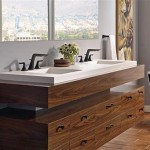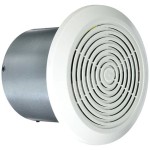Small Plug-In Heaters for Bathroom Use: Considerations and Options
Bathrooms, often smaller and more poorly insulated than other rooms in a house, can be particularly susceptible to cold temperatures. This can make showering, bathing, or even simply using the facilities an uncomfortable experience, especially during colder months. While central heating systems may provide some warmth, they are often not sufficient to quickly and efficiently heat a bathroom to a comfortable temperature. This is where small, plug-in heaters for bathrooms can provide a practical and cost-effective solution.
These portable heaters offer a focused and rapid heating option, allowing individuals to quickly warm the bathroom before and during use. Their compact size and plug-in functionality make them easy to install and move as needed. However, selecting the right small plug-in heater for a bathroom requires careful consideration of several factors, including safety features, heating capacity, energy efficiency, and overall suitability for the specific bathroom environment.
Safety Considerations for Bathroom Heaters
The primary concern when using any electrical appliance in a bathroom is safety. Bathrooms are inherently humid environments, and the proximity of water increases the risk of electrical shock. Therefore, it is imperative that any small plug-in heater intended for bathroom use is specifically designed and certified for such applications. Look for heaters that bear recognized safety certifications from organizations like UL (Underwriters Laboratories), ETL (Intertek), or CSA (Canadian Standards Association). These certifications indicate that the heater has been tested and meets established safety standards.
Another crucial safety feature is a tip-over switch. This mechanism automatically shuts off the heater if it is accidentally knocked over, preventing potential fires or electrical hazards. Overheat protection is also essential. This feature will automatically turn off the heater if it reaches an unsafe temperature, preventing overheating and potential damage. Many modern heaters also incorporate a cool-touch exterior, minimizing the risk of burns if the heater is accidentally touched.
Furthermore, it is crucial to ensure that the heater is plugged into a Ground Fault Circuit Interrupter (GFCI) outlet. GFCI outlets are designed to quickly cut off power to a circuit if they detect a ground fault, which is a situation where electricity is flowing through an unintended path, such as through water or a person. Most modern bathrooms are required to have GFCI outlets near sinks and other water sources. If the bathroom does not have a GFCI outlet, an adapter or a portable GFCI outlet can be used, although a qualified electrician should be consulted to ensure proper installation and safety.
It is equally important to maintain a safe distance between the heater and any water sources, such as the shower, bathtub, or sink. The manufacturer's instructions will specify the minimum safe distance, which should be strictly adhered to. Never place the heater where it could fall into water. Regularly inspect the heater's cord for any signs of damage, such as cracks, fraying, or exposed wires. If any damage is detected, the heater should be immediately disconnected and repaired or replaced.
Heating Capacity and Bathroom Size
The heating capacity of a small plug-in heater is typically measured in watts. The appropriate wattage for a bathroom heater will depend on the size of the bathroom and the level of insulation. A general guideline is that 10 watts of heating power are required for each square foot of space. For example, a 50-square-foot bathroom would typically require a 500-watt heater. However, this is just a rough estimate, and other factors may influence the required wattage.
Bathrooms with poor insulation, such as those with single-pane windows or uninsulated walls, will require more heating power than well-insulated bathrooms. Similarly, bathrooms located in colder climates will typically require higher wattage heaters. Some heaters offer multiple heat settings, allowing users to adjust the heat output to suit their needs. This can be particularly useful for bathrooms that are used by individuals with different temperature preferences.
It is also important to consider the type of heating technology used by the heater. Ceramic heaters are known for their efficient heat transfer and ability to maintain a consistent temperature. They are often a good choice for bathrooms as they can quickly warm the space and provide a comfortable level of heat. Fan heaters are another common type of bathroom heater. These heaters use a fan to circulate warm air, which can quickly and evenly distribute heat throughout the room. However, fan heaters can be noisier than ceramic heaters. Oil-filled radiators are generally not recommended for bathroom use due to their slow heating time and larger size, which is often impractical in a small bathroom.
When selecting a heater, it is also advisable to consider the maximum room size recommended by the manufacturer. This information is usually provided in the product specifications. Selecting a heater that is too small for the bathroom may result in inadequate heating, while selecting a heater that is too large may waste energy and potentially create an uncomfortable environment. It's always better to err on the side of slightly higher wattage if unsure.
Finally, consider how frequently the bathroom is used. If the bathroom is only used for short periods, a lower-wattage heater may be sufficient. However, if the bathroom is used for longer periods, such as for bathing or showering, a higher-wattage heater may be necessary to maintain a comfortable temperature.
Energy Efficiency and Operating Costs
While the convenience of a small plug-in heater for bathroom use is undeniable, it's vital to consider the energy efficiency and associated operating costs. Higher wattage heaters will consume more electricity and, consequently, result in higher energy bills. Therefore, selecting an energy-efficient heater is crucial for minimizing energy consumption and saving money.
Look for heaters with features that enhance energy efficiency, such as adjustable thermostats and timers. An adjustable thermostat allows users to set the desired temperature, and the heater will automatically cycle on and off to maintain that temperature. This prevents the heater from running continuously at full power, which can waste energy. Timers allow users to set the heater to run for a specific period, such as 15 minutes before a shower. This ensures that the bathroom is warm when needed without wasting energy by heating it unnecessarily.
Some heaters also incorporate features like economy modes or automatic shut-off functions. Economy modes reduce the power consumption of the heater while still maintaining a comfortable temperature. Automatic shut-off functions turn off the heater after a certain period of inactivity, preventing energy waste if the heater is accidentally left on. The heater’s design and materials used contribute to its efficiency. Ceramic heaters often have good heat retention, reducing energy needed to keep the bathroom warm.
Calculating the estimated operating cost of a bathroom heater is also a helpful step. To do this, determine the wattage of the heater and the average number of hours it will be used per day. Then, multiply the wattage by the number of hours to get the daily energy consumption in watt-hours. Divide this number by 1000 to convert it to kilowatt-hours (kWh). Finally, multiply the kWh by the local electricity rate to determine the daily operating cost. For example, a 1500-watt heater used for 30 minutes (0.5 hours) per day at an electricity rate of $0.20 per kWh would cost approximately $0.15 per day to operate (1500 watts x 0.5 hours / 1000 x $0.20/kWh = $0.15).
It is important to note that the actual operating cost may vary depending on factors such as the outside temperature, the level of insulation, and the frequency of use. By carefully considering energy efficiency and calculating the estimated operating cost, individuals can choose a small plug-in heater that provides warmth and comfort without significantly increasing their energy bills. Investing in a slightly more expensive, energy-efficient model often pays off in the long run through reduced energy consumption.
In summary, selecting a small plug-in heater for a bathroom requires a multi-faceted approach, prioritizing safety, matching heating capacity to bathroom size, and considering energy efficiency to minimize operating costs. Paying attention to these factors ensures a comfortable and safe bathroom environment during colder periods.

Mini Space Heater Wall Electric Small Plug In With Adjustable Thermostat And Timer For Rv Home Office Bathroom

400w Ceramic Wall Space Heater Plug In Rotatable Led Display Timer For Office Home Dorm Com

Adruer Small Indoor Heaters 500w Mini Plug In Heater Smart Wall Electric Alpha With Adjustable Thermostat And Timer For Room Home

Lasko Myheat 200 Watt Electric Portable Personal Space Heater Black 100 The Home

Mini Space Heater Wall Electric Small Plug In With Adjustable Thermostat And Timer For Rv Home Office Bathroom

400w Ceramic Wall Space Heater Plug In Rotatable Led Display Timer For Office Home Dorm Com

Adruer Small Indoor Heaters 500w Mini Plug In Heater Smart Wall Electric Alpha With Adjustable Thermostat And Timer For Room Home

Cd08200 Small Portable Ceramic Space Heater For Bathroom And Indoor Home Use Whi

Marey 1 5 Gpm Electric Mini Tankless Shower Water Heater Marey110 The Home

Reviews For Lasko 1500 Watt 7 65 In Electric Bathroom Ceramic Space Heater With Fan And Alci Safety Plug Pg 2 The Home
See Also







